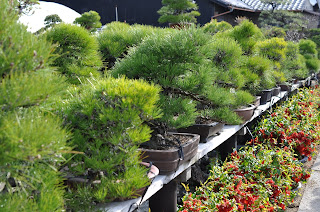Bonsai Soil
Don't get me started on soil! For some reason this topic has confused me over the past few years - to the point where I have become quite frustrated. This I do know - positioning your bonsai tree in good bonsai soil is very important. The roots, being the life source of the tree, must have a home where they feel comfortable. Their home, the soil, becomes vital to the health, growth, and longevity of the tree.
SO WHAT IS THE BEST SOIL?
Brace yourself for this response because you will hear it a lot when learning about bonsai...
IT DEPENDS.
After reading a lot and asking many questions about bonsai soil around Taiwan and in Japan, it can get a little confusing. My purpose with this blog is to try and make things as simple as possible...because that is the way my brain functions.
There is a difference in what soil you use depending on if your tree is a conifer, like a pine or juniper or a deciduous tree, like a maple or elm. Let's keep it simple and talk about conifers and deciduous trees in general. Maybe I can add some more in-depth information in some later posts. But firstly I do want to talk about the function of soil.
The function of soil when dealing with bonsai is for both drainage and retention of water - not to mention sticking the tree in the pot. It was a difficult concept for me to understand because it seems like a contradiction - you want the water to drain well but you also want to retain water!
What I have learnt over time is that we have to find a balance of water drainage and water retention. Think of the soil being the lungs of the tree. As you water, the soil inhales, and as the soil dries throughout the day, the soil is exhaling. This exchange of oxygen that is in the water, and also the tiny spaces between soil grains, are what roots need to survive. They need oxygen and ventilation. Having soil that is too compact will prevent both of these things from happening.
Now conifers and deciduous trees like a different mix of soil. Why does it have to be so hard!
In general terms conifers like soil to be on the dry side so they prefer a really nice free draining soil. Something that is free draining would consist of granular shaped soil, mixed with some river sand. (Sand from the beach is too salty - don't use it)
Deciduous trees prefer to retain a little more water. In this case we add some quality potting mix along with the granular soil, and sand.
Adding small jagged pumice (volcanic rock) to the mix is also a good idea for both conifers and deciduous trees - aids good drainage.
 |
This is an example of granular soil. This particular soil is from the
Taiwan mountain of Yamingshan. |
 |
A mix of sand, some fine, some a little larger. Combining sand and
soil becomes an important combination for the health of a bonsai. |
When I worked at a Japanese bonsai nursery, they used a soil called acadama. Acadama is a granular soil that contains no nutrients at all. It was used for drainage (sand is better for drainage), air circulation and absorption. The grains were jagged which meant that the water drained all the way through to the holes in the base of the pot without a problem but the crevices in the grain also retained water along with the grains themselves of course. This allowed the roots to use the water available to grow.
I was surprised to hear that this particular soil contained no nutrients. My next question was - well, isn't this bad for the tree? The answer lied in the magic word FERTILIZER. They felt that by controlling the amount of nutrients given to the tree by varying the amounts of fertilizer being used meant that they can control the growth rate of the tree itself. If they used soil that had organic compounds in it, they did not have the same degree of control over the tree's growth.
I found this very interesting!
Please be patient...more to come.
Please visit my online pottery shop at AllinoneCeramics for handmade ceramic pieces.





























